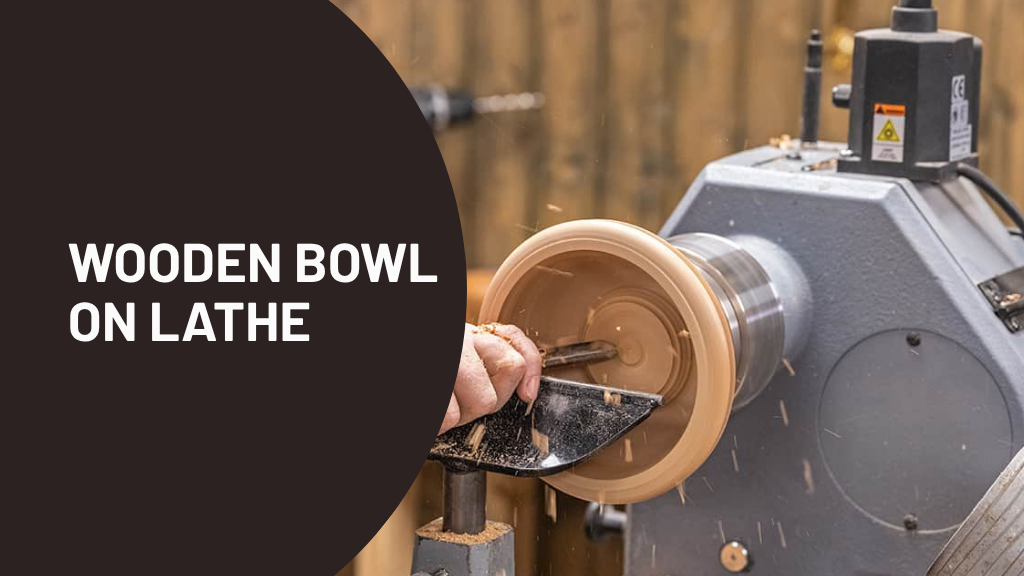The art of woodturning is a rewarding craft that combines creativity with precision. One of the most popular and satisfying projects for woodturners is creating a beautiful wooden bowl on Lathe. The process of transforming a rough log into a smooth, functional piece of art using a lathe is an experience unlike any other. This guide will walk you through everything you need to know, from selecting the right wood to the final finishing touches.
We’ll delve into the tools, techniques, and safety protocols essential for success, ensuring you can confidently embark on your own woodturning journey. Whether you’re a seasoned artisan or a complete novice, this article aims to provide a definitive resource for mastering the craft of turning a wooden bowl on lathe.
The Woodturning Lathe: Your Foundation for Success
Before you can even think about turning a bowl, you need to understand the heart of the operation: the woodturning lathe. This machine is the engine of your craft, and choosing the right one is the first critical step. A wood lathe is a machine that holds a piece of wood and rotates it at high speeds, allowing you to use sharp cutting tools to shape it.
Types of Wood Lathes
There are several types of lathes, each suited for different applications.
- Mini-Lathes: Ideal for small projects like pens, spindles, and small bowls. They are perfect for beginners or those with limited workshop space.
- Midi-Lathes: A great all-around option that balances power and size. They can handle most small-to-medium-sized projects and are a popular choice for hobbyists.
- Full-Size Lathes: These are powerful, heavy-duty machines designed for large-scale projects, including big bowls and furniture parts. They are typically found in professional workshops.
Key Lathe Components
Understanding the parts of your lathe is crucial for safe and effective use.
- Headstock: This is the part that houses the motor and spindle. The spindle holds the wood and spins it.
- Tailstock: A movable part that holds a live center to support the other end of the wood. This is crucial for stability when turning spindles but is often removed for bowl turning.
- Bed: The main body of the lathe, which supports the headstock, tailstock, and tool rest.
- Tool Rest: This adjustable component provides a stable surface for you to rest your turning tools on while you work.
- Banjo: The part that holds the tool rest and allows it to be moved along the bed of the lathe.
Choosing the Right Wood: The First Step to a Masterpiece
The wood you choose will define the character of your bowl. Different woods have unique grain patterns, colors, and working properties. Your choice will depend on factors like availability, cost, and the desired aesthetic of the finished piece.
Hardwoods vs. Softwoods
Generally, hardwoods are preferred for bowl turning due to their density and durability. They hold detail better and are less prone to splintering.
- Hardwoods: Maple, cherry, walnut, and oak are popular choices. They offer beautiful grain patterns and a robust feel.
- Softwoods: While some softwoods like pine or cedar can be turned, they are generally more challenging due to their tendency to tear out or splinter. However, they can be used for practice or specific aesthetic effects.
Green Wood vs. Dried Wood
This is a critical consideration for any bowl turner.
- Green Wood: Freshly cut wood with high moisture content. It’s softer and easier to turn, but it will warp and crack as it dries. Many turners turn a “rough out” bowl from green wood, allow it to dry for several months, and then turn it a second time to its final shape.
- Dried Wood: Wood that has been air-dried or kiln-dried to a low moisture content. It’s more stable but also harder to turn. Turning a bowl from dried wood is a one-step process, but it can be more difficult on your tools.
Essential Tools for Turning a Wooden Bowl on Lathe
Having the right tools is non-negotiable. You don’t need a massive collection, but a few key tools are essential for successfully Turning a Wooden Bowl on Lathe:
Turning Tools
- Roughing Gouge: Used to quickly remove large amounts of wood and turn a square blank into a cylinder.
- Bowl Gouge: This is your primary tool for shaping the exterior and interior of the bowl. It comes in various sizes and grinds. A 1/2-inch or 3/8-inch bowl gouge is a great starting point.
- Scraper: Used for smoothing and refining the surface of the bowl.
- Parting Tool: Used to cut a groove to separate the finished bowl from the waste wood.
Holding the Wood
- Faceplate: A metal disk that screws onto the lathe’s spindle. The wood is then attached to the faceplate with screws. This is the most common method for the initial roughing stage of a bowl.
- Scroll Chuck: A versatile accessory that holds the bowl by expanding into a recess or gripping a tenon (a small protrusion) on the wood. It allows for turning both the outside and inside of the bowl.
Safety First: A Non-Negotiable Priority
Woodturning is a safe hobby if you respect the power of the machinery. Ignoring safety can lead to serious injury.
- Eye Protection: Always wear a full-face shield. Wood can splinter and fly off the lathe at high speeds.
- Dust Mask/Respirator: Wood dust, especially from exotic woods, can be harmful to your lungs.
- Appropriate Clothing: Avoid loose-fitting clothes, long sleeves, or dangling jewelry that could get caught in the spinning lathe.
- Tool Sharpening: A sharp tool is a safe tool. A dull tool requires more force, increasing the risk of a catch or slip.
Step-by-Step Guide to Turning Your First Wooden Bowl on Lathe
This section will detail the entire process, from preparing the wood to the final finish.
1: Preparing the Wood Blank
- Select your wood: Choose a piece of wood slightly larger than your desired bowl size.
- Rough it out: Using a bandsaw or chainsaw, cut the wood into a roughly circular shape. This makes it easier and safer to turn.
- Find the center: Mark the center of the blank on both sides. This is where you’ll attach the faceplate.
- Attach the faceplate: Securely screw the faceplate to the bottom of the wood blank, ensuring the screws are long enough to hold firmly but not so long that they go through the bowl.
2: Mounting and Roughing Out the Bowl
- Mount the blank: Screw the faceplate with the attached wood onto the lathe’s spindle.
- Safety check: Ensure all components are tight and the banjo and tool rest are locked down.
- Start slow: Begin with a low speed and gradually increase it.
- Roughing: Use a roughing gouge to turn the square blank into a smooth cylinder.
- Shaping the exterior: Use a bowl gouge to begin shaping the outside of the bowl. Focus on a smooth, continuous curve.
3: Hollowing the Interior
- Change your grip: Remove the faceplate and use a scroll chuck to hold the bowl by its base.
- Turn a tenon: Use a parting tool to create a tenon (a small projection) on the bottom of the bowl. This will be used to hold the bowl in the chuck.
- Hollowing: Once the bowl is securely in the chuck, use your bowl gouge to begin hollowing out the interior. Start from the center and work your way outward, creating a consistent wall thickness.
4: Finishing and Sanding
- Refining the shape: Use scrapers and gouges to get the final shape and a smooth surface.
- Sanding: Start with a low grit (e.g., 80 or 120) and work your way up to a high grit (e.g., 320 or 400). Sanding on the lathe is a key step to a professional finish.
- Removing the tenon: Once you’re satisfied with the sanding, use a parting tool to carefully separate the bowl from the tenon. You may need to finish the bottom by hand with a sanding block.
5: Applying a Finish
The finish protects the wood and enhances its natural beauty.
- Oil Finishes: Penetrating oils like tung oil or walnut oil provide a natural, food-safe finish. They soak into the wood, highlighting the grain.
- Waxes: Carnauba wax or beeswax can be used for a soft luster and protective layer.
- Polyurethane or Lacquer: These provide a hard, durable, and waterproof finish, but may not be food-safe depending on the product.
Advanced Techniques and Tips for a Better Bowl
Once you’ve mastered the basics, you can explore more advanced techniques.
Turning a “Green” Bowl
As mentioned, turning green wood is a common practice. Many turners create a rough shape from green wood and then allow it to dry for several months. During this time, the wood will naturally warp, creating unique, non-symmetrical shapes. Once dry, the bowl is re-mounted on the lathe and turned a second time to its final, thin-walled shape. This technique results in a highly stable, finished piece.
Curing the Wood
A simple way to cure a green bowl is to place it in a paper bag with some wood shavings. This allows the moisture to escape slowly, reducing the risk of cracking. You can weigh the bowl periodically; once its weight stabilizes, it’s dry enough for the final turning.
Grain Orientation
The orientation of the wood grain can dramatically affect the final look and stability of your bowl.
- Face Grain: Turning a bowl from a face grain blank results in a classic, concentric ring pattern.
- End Grain: Turning an end grain bowl can be more challenging but can reveal intricate patterns and a unique aesthetic.
Conclusion:
Turning a wooden bowl on lathe is a journey of skill, patience, and creativity. Each piece you create is a unique reflection of your effort and the natural beauty of the wood itself. From the initial roughing to the final polish, the process is deeply satisfying.
FAQs
How long does it take to turn a wooden bowl?
The time it takes varies greatly. A woodworker can turn a simple, small bowl from dried wood in a few hours. A large, complex bowl from green wood that requires a second turning can take months, including the drying time.
What is the best wood for a beginner to turn?
Maple is an excellent choice for beginners. It’s relatively inexpensive, widely available, and has a consistent grain that’s easy to work with.
Can I turn a bowl on a small lathe?
Yes, many mini-lathes are capable of turning small bowls. A small lathe will limit you with its swing and the distance between its centers. Always check your lathe’s specifications.
What are common mistakes beginners make?
A common mistake is using a dull tool, which leads to catches and poor cuts. Another common mistake is rushing the sanding process. Patience is a virtue in woodworking; take your time.




